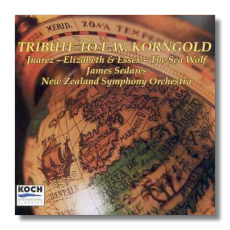
The Internet's Premier Classical Music Source
Related Links
- Korngold Reviews
- Latest Reviews
- More Reviews
-
By Composer
-
Collections
DVD & Blu-ray
Books
Concert Reviews
Articles/Interviews
Software
Audio
Search Amazon
Recommended Links
Site News
 CD Review
CD Review
Tribute To Erich Wolfgang Korngold

- Music from "Juarez," "Elizabeth and Essex," and "The Sea Wolf"
New Zealand Symphony Orchestra/James Sedares
Koch International Classics 3-7302-2H1 DDD 60:28
Forty years ago, the idea of making new commercial recordings of Korngold's film music was unthinkable – only the most specialized audiences would have wanted such a thing, most record executives believed. Then, beginning in 1972, conductor Charles Gerhardt, working with RCA Victor, proved that the music of Korngold, Steiner, Waxman, and others was both financially and artistically viable, and a series of recordings ensued. The so-called "Classic Film Scores" series was highly successful, and its influence can be felt decades later in productions such as the one reviewed here.
"Juarez" is a historical epic about Maximilian, Archduke of Austria, who was named Emperor of Mexico by Louis Napoleon, and left to fend for himself when France's hold on Mexican politics went slack. Bette Davis played his tragic wife Carlotta in this film, which was completed in 1939. Although Korngold quotes "La Paloma," he disdains musical stereotypes. He doesn't go against the film's epic grain, however. The most memorable music goes to Carlotta, who is driven mad by her inability to have a child, by Louis Napoleon's callousness, and by Maximilian's eventual death. "Elizabeth and Essex," also from 1939, featured Davis again – this time as English queen Elizabeth I. The film's central conflict is that between love for a man – the Earl of Essex (Errol Flynn) – and love for country. In the end, England wins out, and Essex loses his head. The cues presented here are associated with the film's pomp and pageantry. Korngold's music took a darker and more intimate turn with "The Sea Wolf" (1941) In this film, based on Jack London's story, Edward G. Robinson played a half-mad sea captain who holds a young woman "with a past" and a writer as de facto hostages on his ship. Murder and mayhem ensue, but there is a happy ending as the woman (Ida Lupino) escapes with a male convict (John Garfield) whom Robinson also had been holding against his will. There is a striking love theme for the two of them, memorably scored for solo harmonica.
Gerhardt, who died recently, touched on all three of these scores in the Classic Film Scores series. He recorded about eight minutes of music from "Elizabeth and Essex," a seven-minute suite from "The Sea Wolf," and a single cue from "Juarez." Sedares offers significantly more music: more than 27 minutes of music from "Juarez" and "The Sea Wolf" (16 and 13 cues, respectively), and 6 minutes of music from "Elizabeth and Essex" (3 cues). We are not told who was responsible for putting the cues together in such a manner as to produce a more or less continuous suite. (This is the same approach that Gerhardt took on his recordings.) He or she did a good job, though; in spite of 32 separate tracks on this disc, the music flows smoothly, and there is no feeling of fragmentation. As for the performances themselves, Sedares doesn't have Gerhardt's sweep and excitement, and the music-making on this disc is of a lower voltage than in the "Classic Film Scores" series. Nevertheless, Sedares has prepared his orchestra with care, and it is clear that he and the New Zealanders have a genuine affection for Korngold's music. This is not hard, because it is so lovable!
Copyright © 2000, Raymond Tuttle


















